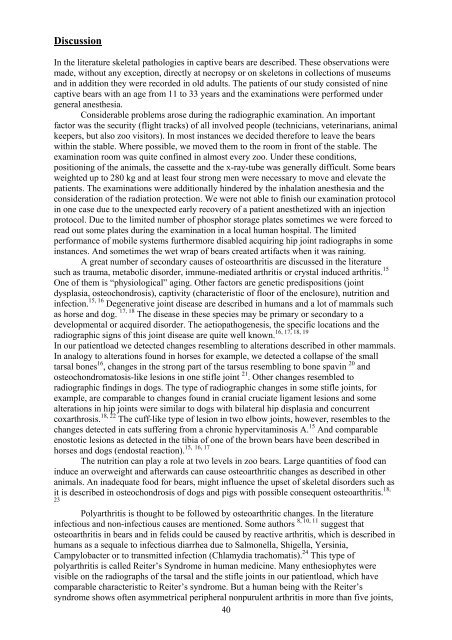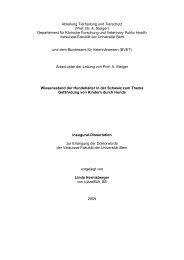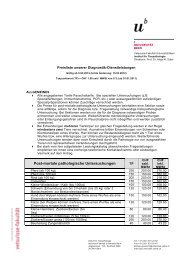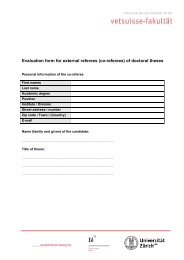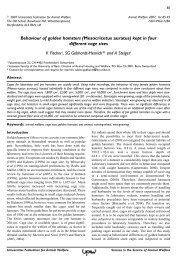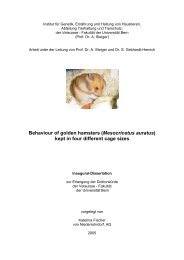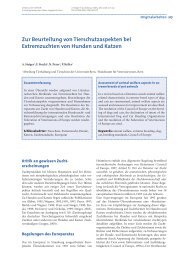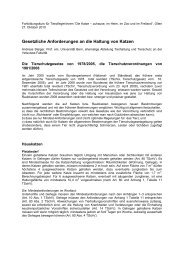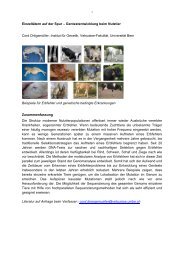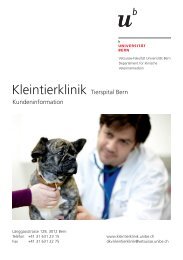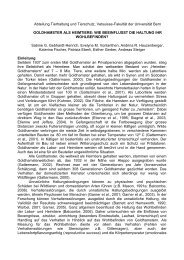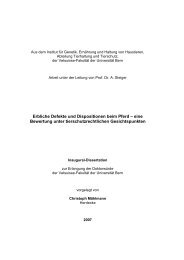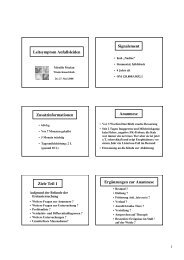Radiographic findings in several joints of nine bears
Radiographic findings in several joints of nine bears
Radiographic findings in several joints of nine bears
Create successful ePaper yourself
Turn your PDF publications into a flip-book with our unique Google optimized e-Paper software.
Discussion<br />
In the literature skeletal pathologies <strong>in</strong> captive <strong>bears</strong> are described. These observations were<br />
made, without any exception, directly at necropsy or on skeletons <strong>in</strong> collections <strong>of</strong> museums<br />
and <strong>in</strong> addition they were recorded <strong>in</strong> old adults. The patients <strong>of</strong> our study consisted <strong>of</strong> n<strong>in</strong>e<br />
captive <strong>bears</strong> with an age from 11 to 33 years and the exam<strong>in</strong>ations were performed under<br />
general anesthesia.<br />
Considerable problems arose dur<strong>in</strong>g the radiographic exam<strong>in</strong>ation. An important<br />
factor was the security (flight tracks) <strong>of</strong> all <strong>in</strong>volved people (technicians, veter<strong>in</strong>arians, animal<br />
keepers, but also zoo visitors). In most <strong>in</strong>stances we decided therefore to leave the <strong>bears</strong><br />
with<strong>in</strong> the stable. Where possible, we moved them to the room <strong>in</strong> front <strong>of</strong> the stable. The<br />
exam<strong>in</strong>ation room was quite conf<strong>in</strong>ed <strong>in</strong> almost every zoo. Under these conditions,<br />
position<strong>in</strong>g <strong>of</strong> the animals, the cassette and the x-ray-tube was generally difficult. Some <strong>bears</strong><br />
weighted up to 280 kg and at least four strong men were necessary to move and elevate the<br />
patients. The exam<strong>in</strong>ations were additionally h<strong>in</strong>dered by the <strong>in</strong>halation anesthesia and the<br />
consideration <strong>of</strong> the radiation protection. We were not able to f<strong>in</strong>ish our exam<strong>in</strong>ation protocol<br />
<strong>in</strong> one case due to the unexpected early recovery <strong>of</strong> a patient anesthetized with an <strong>in</strong>jection<br />
protocol. Due to the limited number <strong>of</strong> phosphor storage plates sometimes we were forced to<br />
read out some plates dur<strong>in</strong>g the exam<strong>in</strong>ation <strong>in</strong> a local human hospital. The limited<br />
performance <strong>of</strong> mobile systems furthermore disabled acquir<strong>in</strong>g hip jo<strong>in</strong>t radiographs <strong>in</strong> some<br />
<strong>in</strong>stances. And sometimes the wet wrap <strong>of</strong> <strong>bears</strong> created artifacts when it was ra<strong>in</strong><strong>in</strong>g.<br />
A great number <strong>of</strong> secondary causes <strong>of</strong> osteoarthritis are discussed <strong>in</strong> the literature<br />
such as trauma, metabolic disorder, immune-mediated arthritis or crystal <strong>in</strong>duced arthritis. 15<br />
One <strong>of</strong> them is “physiological” ag<strong>in</strong>g. Other factors are genetic predispositions (jo<strong>in</strong>t<br />
dysplasia, osteochondrosis), captivity (characteristic <strong>of</strong> floor <strong>of</strong> the enclosure), nutrition and<br />
<strong>in</strong>fection. 15, 16 Degenerative jo<strong>in</strong>t disease are described <strong>in</strong> humans and a lot <strong>of</strong> mammals such<br />
as horse and dog. 17, 18 The disease <strong>in</strong> these species may be primary or secondary to a<br />
developmental or acquired disorder. The aetiopathogenesis, the specific locations and the<br />
radiographic signs <strong>of</strong> this jo<strong>in</strong>t disease are quite well known.<br />
16, 17, 18, 19<br />
In our patientload we detected changes resembl<strong>in</strong>g to alterations described <strong>in</strong> other mammals.<br />
In analogy to alterations found <strong>in</strong> horses for example, we detected a collapse <strong>of</strong> the small<br />
tarsal bones 16 , changes <strong>in</strong> the strong part <strong>of</strong> the tarsus resembl<strong>in</strong>g to bone spav<strong>in</strong> 20 and<br />
osteochondromatosis-like lesions <strong>in</strong> one stifle jo<strong>in</strong>t 21 . Other changes resembled to<br />
radiographic <strong>f<strong>in</strong>d<strong>in</strong>gs</strong> <strong>in</strong> dogs. The type <strong>of</strong> radiographic changes <strong>in</strong> some stifle jo<strong>in</strong>ts, for<br />
example, are comparable to changes found <strong>in</strong> cranial cruciate ligament lesions and some<br />
alterations <strong>in</strong> hip jo<strong>in</strong>ts were similar to dogs with bilateral hip displasia and concurrent<br />
coxarthrosis. 18, 22 The cuff-like type <strong>of</strong> lesion <strong>in</strong> two elbow jo<strong>in</strong>ts, however, resembles to the<br />
changes detected <strong>in</strong> cats suffer<strong>in</strong>g from a chronic hypervitam<strong>in</strong>osis A. 15 And comparable<br />
enostotic lesions as detected <strong>in</strong> the tibia <strong>of</strong> one <strong>of</strong> the brown <strong>bears</strong> have been described <strong>in</strong><br />
horses and dogs (endostal reaction).<br />
15, 16, 17<br />
The nutrition can play a role at two levels <strong>in</strong> zoo <strong>bears</strong>. Large quantities <strong>of</strong> food can<br />
<strong>in</strong>duce an overweight and afterwards can cause osteoarthritic changes as described <strong>in</strong> other<br />
animals. An <strong>in</strong>adequate food for <strong>bears</strong>, might <strong>in</strong>fluence the upset <strong>of</strong> skeletal disorders such as<br />
it is described <strong>in</strong> osteochondrosis <strong>of</strong> dogs and pigs with possible consequent osteoarthritis. 18,<br />
23<br />
Polyarthritis is thought to be followed by osteoarthritic changes. In the literature<br />
<strong>in</strong>fectious and non-<strong>in</strong>fectious causes are mentioned. Some authors 8, 10, 11 suggest that<br />
osteoarthritis <strong>in</strong> <strong>bears</strong> and <strong>in</strong> felids could be caused by reactive arthritis, which is described <strong>in</strong><br />
humans as a sequale to <strong>in</strong>fectious diarrhea due to Salmonella, Shigella, Yers<strong>in</strong>ia,<br />
Campylobacter or to transmitted <strong>in</strong>fection (Chlamydia trachomatis). 24 This type <strong>of</strong><br />
polyarthritis is called Reiter’s Syndrome <strong>in</strong> human medic<strong>in</strong>e. Many enthesiophytes were<br />
visible on the radiographs <strong>of</strong> the tarsal and the stifle jo<strong>in</strong>ts <strong>in</strong> our patientload, which have<br />
comparable characteristic to Reiter’s syndrome. But a human be<strong>in</strong>g with the Reiter’s<br />
syndrome shows <strong>of</strong>ten asymmetrical peripheral nonpurulent arthritis <strong>in</strong> more than five jo<strong>in</strong>ts,<br />
40


